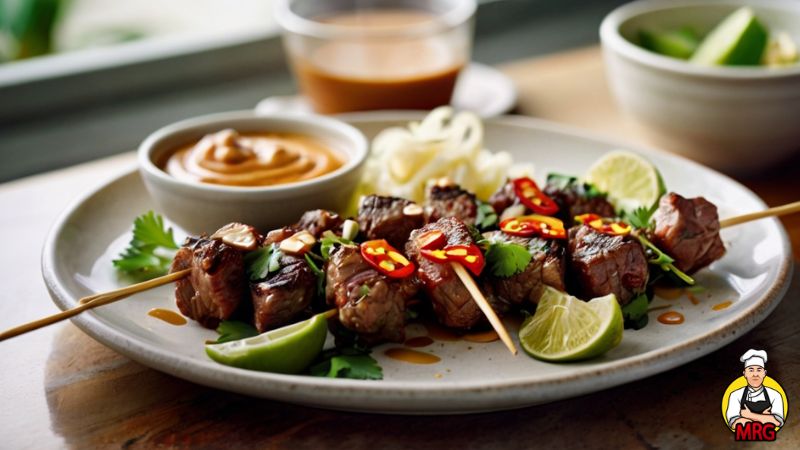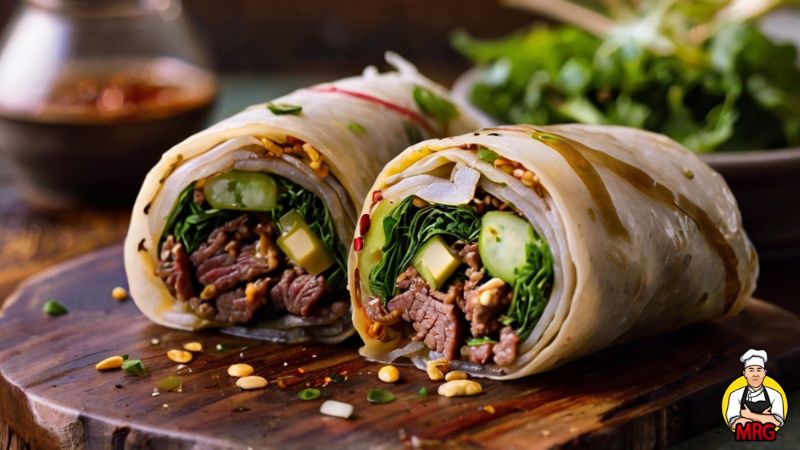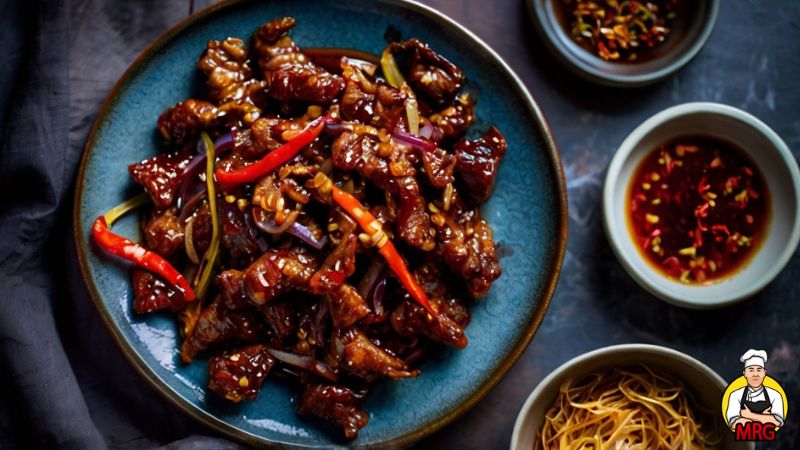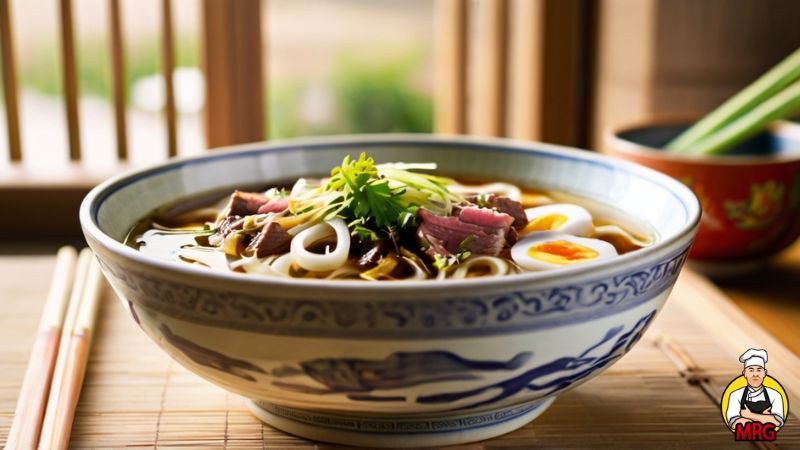When it comes to flavor-packed dishes, the beef satay recipe stands out. This dish, known for its mouthwatering taste, is a favorite in many households and Thai restaurants. The combination of tender beef, a rich Thai peanut sauce, and the perfect blend of spices creates an unforgettable culinary experience. Personally, I find the beef satay to be the ideal dish for family gatherings or a casual BBQ with friends. Its unique taste and versatility make it suitable for any meal or occasion.
Choosing the Right Main Ingredient
The success of your beef satay recipe starts with selecting the right beef cuts. Opt for tender cuts like rump steak or top-shelf meat. These cuts are not only tender but also absorb the marinade well, ensuring a flavorful outcome. Always choose fresh, premium cuts for the best results.
Seasoning: The Key to Flavor
Seasoning plays a crucial role in achieving the authentic taste of Thai beef satay. Use a mix of curry paste, soy sauce, and baking soda to tenderize the meat. Adding coconut milk gives a rich coconut flavor that balances the umami of the beef. For the marinade, a blend of peanut butter, vinegar, and coriander works wonders.
Recommended Cooking Equipment
To achieve the perfect beef satay recipe, the right equipment is essential. Here’s a quick guide:
- Skewers: Bamboo or metal skewers are ideal. Soak bamboo skewers in water for at least 30 minutes before use to prevent burning.
- Grill: A charcoal grill adds an authentic smoky flavor. However, a gas grill or griddle pan works well too.
- Griddle Pan or Skillet: If grilling isn’t an option, a griddle pan or a heavy skillet can be used on the stovetop to cook the satay evenly.
How to Use Equipment Effectively
- Preparing the Grill: Preheat your charcoal or gas grill to medium-high heat. If using a charcoal grill, ensure the coals are white-hot before placing the skewers on the grill. This ensures even cooking and that the beef achieves a perfect char.
- Using Skewers: Thread the marinated beef onto the skewers, ensuring the pieces are evenly spaced. This allows for even cooking and prevents the meat from steaming instead of grilling.
- Cooking on a Griddle Pan or Skillet: Preheat the griddle pan or skillet over medium-high heat. Add a little oil to prevent sticking. Place the skewers on the pan and cook for about 2-3 minutes on each side or until the beef is medium-well done.
Comprehensive Beef Satay Recipe
Beef Satay Recipe
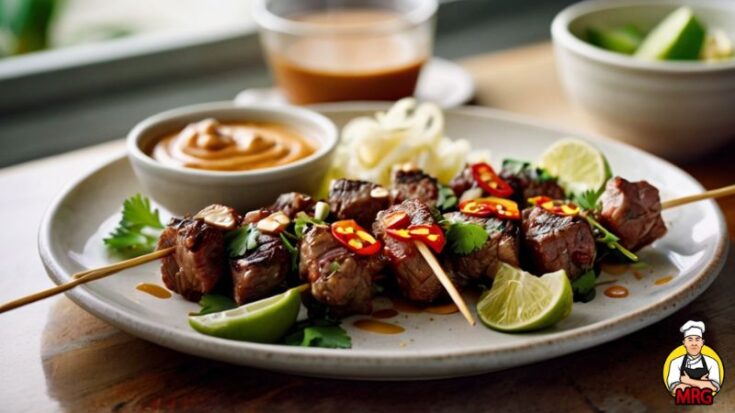
Beef Satay Recipe: I absolutely love this dish for its rich, savory flavors and delightful combination of tender beef and creamy Thai peanut sauce. It’s a perfect balance of spices and textures, making it an ideal choice for any occasion, from casual family dinners to festive gatherings. The aroma alone is simply irresistible.
Ingredients
- 1 pound rump steak or top-shelf meat, thinly sliced
- 1/2 cup coconut milk
- 2 tablespoons curry paste
- 1 tablespoon soy sauce
- 1 tablespoon peanut butter
- 1 tablespoon vinegar
- 1 teaspoon baking soda
- 1 tablespoon coriander, finely chopped
- Skewers (bamboo or metal)
Thai Peanut Sauce
- 1/2 cup peanut butter
- 1/2 cup coconut milk
- 2 tablespoons soy sauce
- 1 tablespoon vinegar
- 1 tablespoon sugar
- 1 teaspoon curry paste
- 1 tablespoon water (if needed, to thin the sauce)
Instructions
Marinate the Beef:
- In a bowl, mix the coconut milk, curry paste, soy sauce, peanut butter, vinegar, baking soda, and coriander.
- Add the thinly sliced beef to the marinade, ensuring each piece is well coated.
- Cover and refrigerate for at least 1 hour, allowing the flavors to infuse and the beef to tenderize.
Prepare the Skewers:
- If using bamboo skewers, soak them in water for at least 30 minutes.
- Thread the marinated beef onto the skewers, spacing the pieces evenly.
Grill the Beef:
- Preheat your grill to medium-high heat.
- Place the skewers on the grill and cook for 2-3 minutes on each side, or until the beef is medium-well done and has a nice char.
Make the Thai Peanut Sauce:
- In a small saucepan, combine peanut butter, coconut milk, soy sauce, vinegar, sugar, and curry paste.
- Cook over medium heat, stirring constantly, until the sauce is smooth and slightly thickened. Add water if necessary to achieve the desired consistency.
Nutrition Information:
Yield:
4Serving Size:
1Amount Per Serving: Calories: 714Total Fat: 45gCarbohydrates: 15gProtein: 38g
Serving Suggestions
Serve the beef satay with the Thai peanut sauce on the side. This dish pairs wonderfully with jasmine rice or fresh salad. For an authentic touch, garnish with fresh coriander and lime wedges. The savory and slightly spicy beef satay, combined with the rich peanut sauce, creates a balanced and delicious meal.
Useful Cooking Tips
- Tenderizing the Beef: Using baking soda in the marinade helps tenderize the beef, making it more succulent.
- Avoid Overcooking: To keep the beef tender and juicy, avoid overcooking. Aim for medium-well done.
- Adjusting the Spice Level: If you prefer a milder taste, reduce the amount of curry paste in the marinade and sauce.
Common Mistakes to Avoid
- Skipping the Soaking of Bamboo Skewers: Not soaking bamboo skewers can cause them to burn during grilling.
- Overcrowding the Skewers: Overcrowding can lead to uneven cooking. Ensure each piece of beef has enough space.
- Ignoring the Marinating Time: Marinating is crucial for flavor infusion and tenderizing. Don’t skip this step.
Conclusion
Creating the perfect beef satay recipe is all about balance – the right ingredients, precise cooking, and a flavorful peanut sauce. This dish is not only delicious but also versatile, making it a great addition to any meal. Whether you’re hosting a BBQ, preparing a family dinner, or simply indulging in a flavorful treat, beef satay is sure to impress. Enjoy your cooking and relish the delightful flavors of this Thai classic!
Related Article:
I’m Calvin Lamb, an LA-based culinary enthusiast with a decade’s experience in five-star kitchens. My innovative dishes, inspired by seasonal flavors and sustainable practices, blend classic and modern cuisine. Besides crafting unique culinary experiences, I relish exploring new eateries and devising fresh recipes.
